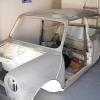
Mig 145 Welder.
#1

Posted 28 April 2013 - 06:56 AM
Is this welder any good for learning on? Thanks
#2

Posted 28 April 2013 - 07:03 AM
The amps are quite important as if the welder can't produce a hot enough weld the two pieces of metal won't fuse properly and you'll just produce a weak joint
So yes sounds alright to me and £65 is very reasonable, assuming it works ect
Trac
Edited by tractor, 28 April 2013 - 07:05 AM.
#3

Posted 28 April 2013 - 07:16 AM
You will be at around 60a on most things on a mini aside from inner wings and flitch panels. The bigger your welder's capacity the longer it can weld for at a given amperage. It would have a 100% duty cycle at about 60.
#4

Posted 28 April 2013 - 10:30 AM
You will be at around 60a on most things on a mini aside from inner wings and flitch panels. The bigger your welder's capacity the longer it can weld for at a given amperage. It would have a 100% duty cycle at about 60.
What does the percentage duty cycle actually mean?
#5

Posted 28 April 2013 - 11:01 AM
#6

Posted 28 April 2013 - 06:47 PM
Say your welder was 100A and it has a duty cycle of 50% at 50A which means it can weld for 5 in every ten minutes without overheating. You can calculate it retrospectively by changing the power setting used and the time. There should be a plate on your welder somewhere.
#7

Posted 01 May 2013 - 11:52 AM
Beware - Screwfix (and no doubt others) were selling a bunch of cheap MIG welders before Christmas that didn't have a low enough setting to weld car bodywork thickness metal. A good few people bought them just thinking bigger is better and then realised that they were no good for what they actually wanted to do with them - they are now finding their way onto the second hand market cheap. Can't remember what the make is but I think they had red cases.
As has been said you don't need anything like 145 Amps for car bodywork stuff but generally a bigger machine will be able to do the smaller stuff without breaking a sweat. Duty cycle has been explained but it can be a bit mis-leading when looked at in such simplistic terms. When you are welding you rarely have the trigger pressed all the time. You weld a bit, you stop and look at it to check it's OK, you weld a bit more somewhere else on the patch, you stop to check again and maybe belt it with a hammer if it's distorting through the heat or you move a clamp, then you weld a bit more, then you stop whilst you move to a more comfortable position, etc. In practice my Clarke 150 can "weld" all day and has an effective real world duty cycle of 100% for my use.
Iain
#8

Posted 01 May 2013 - 12:06 PM
Personal preference but I'd also check if its gas or no-gas...I prefer gas
1 user(s) are reading this topic
0 members, 1 guests, 0 anonymous users















